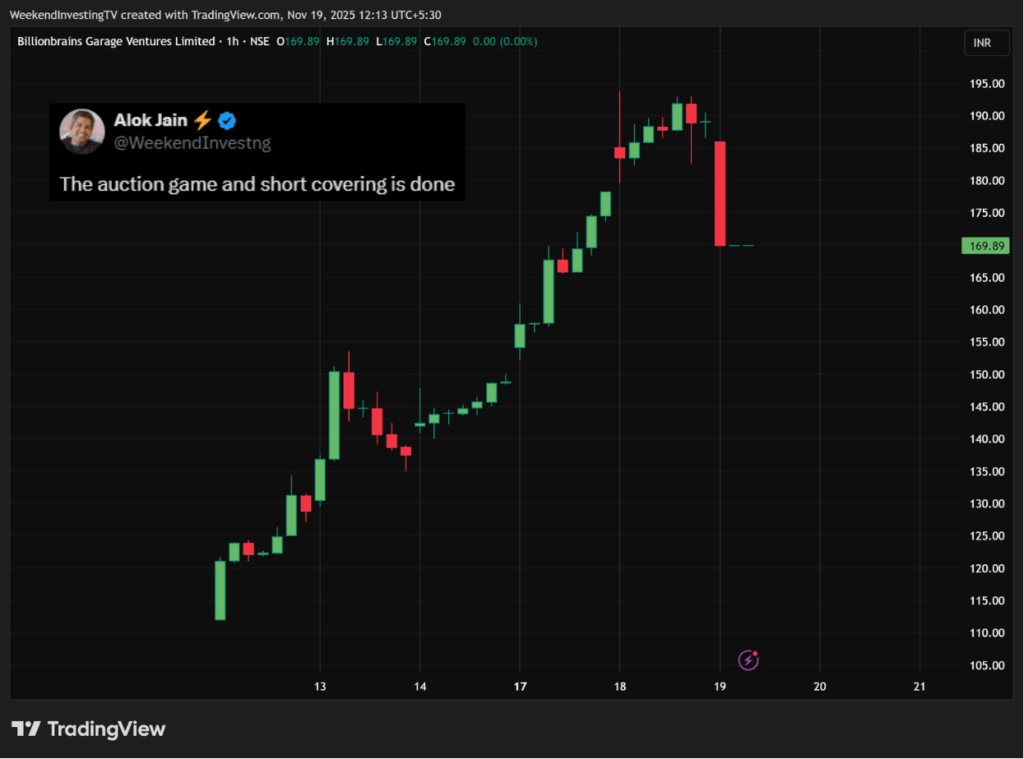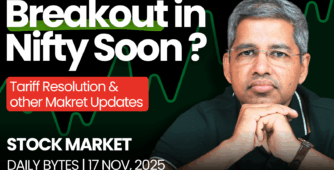Where is the market headed?
It was a decent day following yesterday’s expiry. The markets finally seem to be decisively closing above the 26,000 mark. We are now a stone’s throw away from an all-time high weekly close, and not too far from the daily closing high either, as we will see in the charts.
What’s working in our favor is the strong performance in certain sectors, particularly PSU banking. The surprise performer is the IT sector, which is zooming up very smartly. Nobody expected the IT services space to become an anti-AI play, but it seems as AI stocks cool off, money is rotating into IT services, which is now poised for a breakout.
Globally, there are fresh rumors that the India-US tariff deal is about to close. Furthermore, President Putin is trying to woo India with offers of higher technology defense arms ahead of his visit in a couple of weeks. India’s policy of maintaining neutrality and wooing both sides of the table appears to be working well, placing the country in a favorable diplomatic position right now.
Market Overview
The Nifty closed up 0.55% today, pretty much at the highest point recently and not far off the last year’s high. On the weekly chart, this is probably the second time we’ve crossed 26,000. On the daily chart, this is likely the ninth attempt to decisively cross 26,000 in the last month. Once this level is cleared, the next thousand-point milestone could be achieved very quickly.
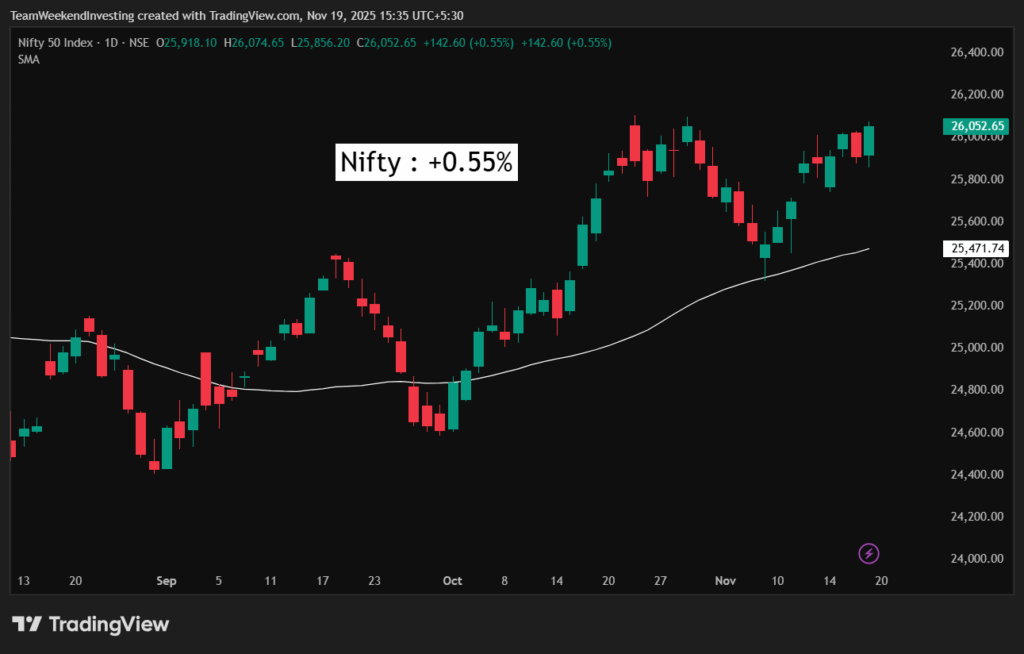
Nifty Next 50
However, the broader market was less committal. Nifty Junior was marginally negative at -0.01%, showing the pull is concentrated in the large-cap space.

Nifty Mid and Small Cap
Midcaps were up 0.32%, but Small caps were also not participating, down 0.42%. In fact, the small-cap move looks like a flag pattern and could easily test the previous two bottoms, suggesting a temporary shift in market dynamics towards larger caps.

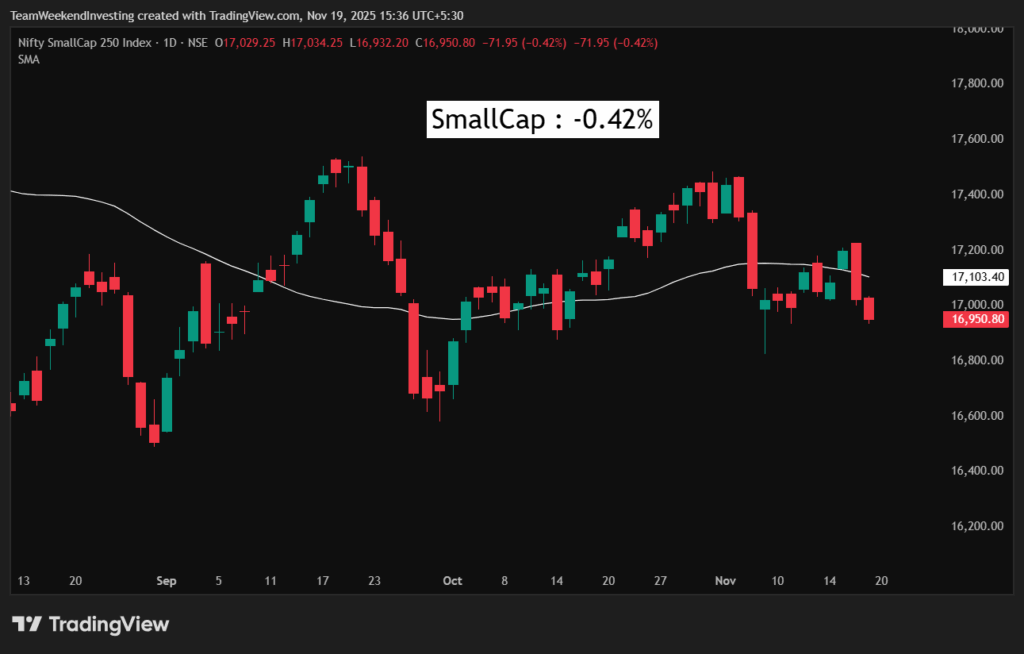
Bank Nifty
The Bank Nifty is zooming, largely led by PSU banks, hitting a new all-time high of 59,216. As Bank Nifty often leads the market’s direction, its ascent provides confidence that the Nifty may also hit new highs, even if the broader market lags temporarily.
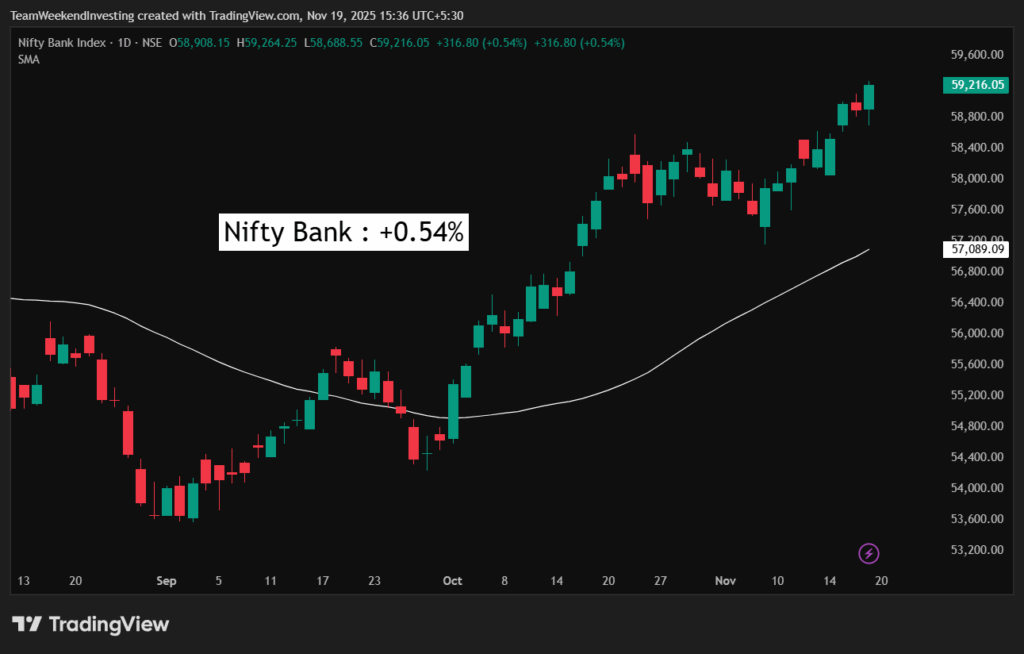
GOLD
Gold has again taken support at its average and moved up, not appearing weak at all. Above the two-day high, we could see rapid upward action, similar to a previous surge. Many people who have dismissed gold as having topped out may be very surprised soon. Gold was up 1.21%.

SILVER
Even more notably, Silver surged 2.55% and is poised to potentially form a cup and handle pattern, which could surprise everyone in the coming times.
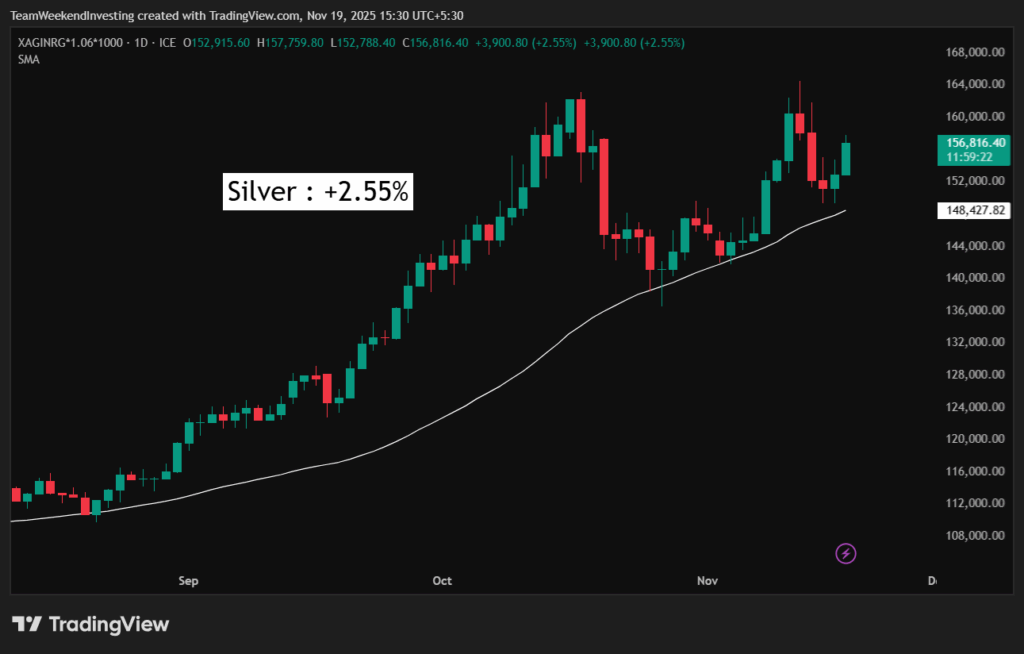
Advance Decline Ratio
The Advanced Decline ratio wasn’t overwhelmingly in favor of advances, but the advances were steadily gaining momentum throughout the day while declines were reducing, which is a silver lining.
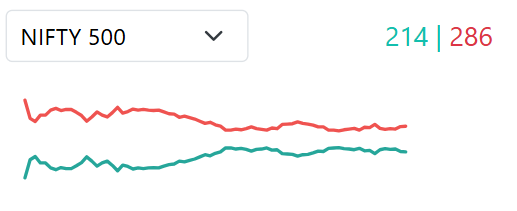
Heat Maps
IT stocks were shining, with Infosys up 3.68%, and HCL Tech, TCS, and Wipro all doing well. Hindustan Lever also performed well on news of a potential demerger. State Bank of India, Kotak Bank, and ICICI Bank also gained. Stocks losing ground included ITC, Maruti, Coal India, Adani Ports, and Bajaj Finance.
In the Nifty Next 50 space, LTIM, Naukri, PNB, Bank of Baroda (PSU banks), and Motherson did well. Losers included Havells, CG Power, Siemens (in the capital goods space), United Spirits, JSW Steel, Adani Green Energy, Chola Finance, and DLF.


Mover Of The Day
The Mover of the Day was JP Power, which surged 15% after news that the Adani-Jaiprakash Associates deal got through. Given Jaiprakash Associate’s restructuring and Adani’s interest in JP Power’s valuable assets, this news powered the one-session move.

Sectoral Overview
Sectoral Trends saw Nifty IT as the top performer, with a remarkable near 3% jump. Despite this surge, Nifty IT is still down 11% over the last year. This short-term move could signal a potential reversal. PSU Banks were second, up 1.16%, followed by Capital Markets at 1.12% (despite a new entrant hitting lower circuits). The Services sector was up 0.83%, and Banking as a whole gained half a percent. Losses in any sector were minor, with the biggest loss at only 0.38%.

Sector of the Day
Nifty IT Index
The chart for the IT space shows the index closing at the top end of its recent trading range, suggesting a high potential for a breakout. HCL Tech, Persistent Systems, Coforge, LTI Mindtree, and Infosys all performed well today.
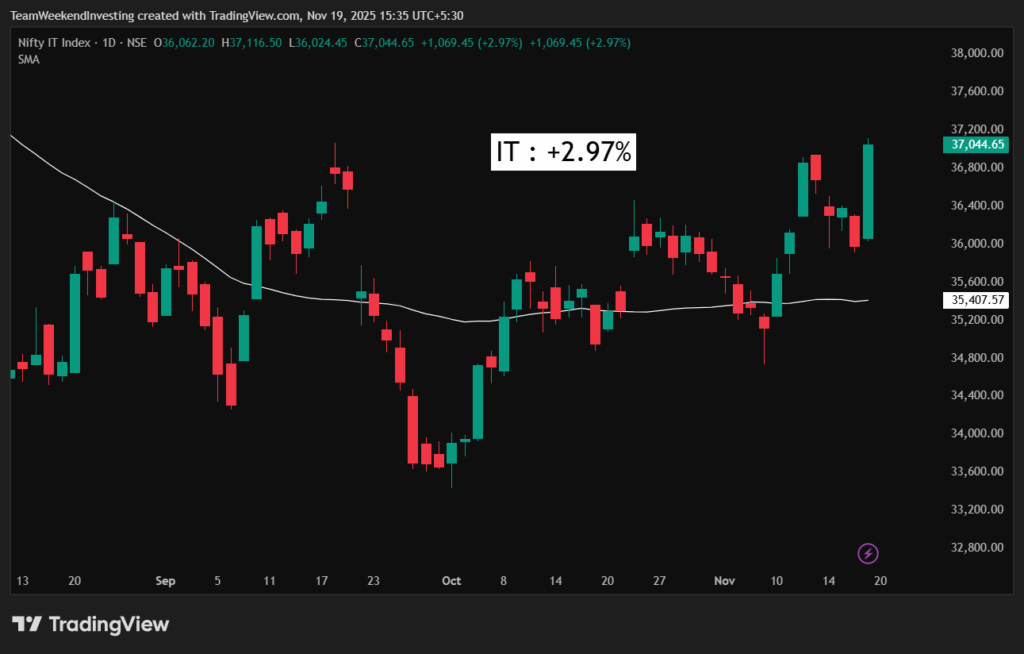

U.S. Market
In the previous session, US Markets were negative for the second consecutive day. Over the last month, the US markets have not made any gains. The S&P 500 was down 0.8%, Dow Jones 1%, and Nasdaq 1.2% down, though the Russell gained slightly.
On November 18th, Home Depot was smashed down 6%, with its stock price plummeting from $430 to $336. This highlights the absolute necessity of having a planned exit strategy in any structured strategy, rather than just relying on hope.
Other heavyweights also saw big drops: Amazon down 4.43%, AMD down 4%, Nvidia down 2.8% (a massive loss on a $5 trillion valuation), and Microsoft down 2.7%. The disclaimer states that some of these stocks could be part of the Weekend Investing U.S. stock strategy, but they are not recommendations to buy or sell.


Tweet Of The Day
The first Tweet of the Day from Charlie Bilelo showed two charts: one for Bitcoin (orange) and one for MicroStrategy (MSTR) (blue), the company owned by Michael Saylor, the “torchbearer” for Bitcoin. MSTR is essentially a holding company for Bitcoin, funded by enormous equity and debt raised to buy the cryptocurrency. Saylor’s average purchase price is near $76,000 over the last five years, so there’s hardly been any gain.
The interesting part is that one year ago, MSTR’s market cap was $106 billion, while the value of the Bitcoin it held (its Net Asset Value, or NAV) was only $31 billion, meaning the company traded at a 3.4 times premium to its holdings. Typically, holding companies trade at a discount. Just one year later, even though the Bitcoin NAV has doubled from $30 billion to $60 billion, MSTR’s market cap is now only $59 billion, meaning the premium has collapsed to 0.99 times NAV.
A person who bought MSTR a year ago would have seen their investment value halve, whereas a direct investment in Bitcoin would have doubled. This serves as a vital lesson: you must know what you are owning, why you are owning it, and have a clear exit plan. This same principle applies to many ETFs trading at a premium today; if that premium vanishes, the investor could lose money even if the underlying market moves up. It’s crucial not to be sucked into situations where you have no idea how or when you are going to exit.

The second tweet discussed the price action of the new listing, Groww, which listed very well and saw massive jumps in the days following its listing. At just ₹100 per share, the market cap was already around ₹50,000 crores, which seemed highly speculative. It appears that concentrated parties or “operators” decided to play a game to boost the stock, trapping short sellers. When a short seller is unable to cover their position and cannot deliver the virtually unavailable new stock on the settlement day (T+1), the exchange holds an auction two days later to redeem the buyers.
When the market knows millions of shares must be bought in the auction, the operators bid up the price, forcing the short sellers to buy back at an exorbitant price, often 20% higher. Once this auction event is over, the sellers emerge, buyers vanish, and the stock collapses to find its true equilibrium.
This is a great learning episode for all new investors: don’t get sucked into a rising IPO immediately after its listing. Let it settle; there is no rush to buy immediately if the company is genuinely good for the long term. The stock will likely come down to cover the gaps.
